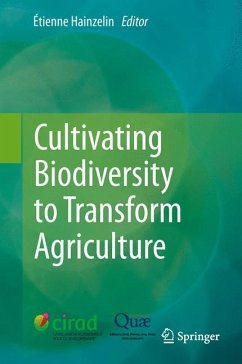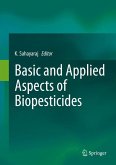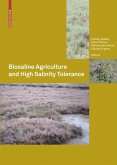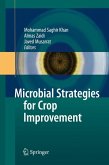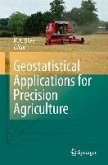Cultivating Biodiversity to Transform Agriculture (eBook, PDF)
Redaktion: Hainzelin, Étienne
72,95 €
72,95 €
inkl. MwSt.
Sofort per Download lieferbar

36 °P sammeln
72,95 €
Als Download kaufen

72,95 €
inkl. MwSt.
Sofort per Download lieferbar

36 °P sammeln
Jetzt verschenken
Alle Infos zum eBook verschenken
72,95 €
inkl. MwSt.
Sofort per Download lieferbar
Alle Infos zum eBook verschenken

36 °P sammeln
Cultivating Biodiversity to Transform Agriculture (eBook, PDF)
Redaktion: Hainzelin, Étienne
- Format: PDF
- Merkliste
- Auf die Merkliste
- Bewerten Bewerten
- Teilen
- Produkt teilen
- Produkterinnerung
- Produkterinnerung

Bitte loggen Sie sich zunächst in Ihr Kundenkonto ein oder registrieren Sie sich bei
bücher.de, um das eBook-Abo tolino select nutzen zu können.
Hier können Sie sich einloggen
Hier können Sie sich einloggen
Sie sind bereits eingeloggt. Klicken Sie auf 2. tolino select Abo, um fortzufahren.

Bitte loggen Sie sich zunächst in Ihr Kundenkonto ein oder registrieren Sie sich bei bücher.de, um das eBook-Abo tolino select nutzen zu können.
How can cultivated plant biodiversity contribute to the transformation and the "ecologization" of agriculture in Southern countries? Based on extensive field work in the Southern countries, a great deal of scientific progress is presented in all areas affecting agriculture (agronomy, plant breeding and crop protection, cultivation systems, etc.) in order to intensify the ecological processes in cultivated plots and at the scale of rural landscapes.
- Geräte: PC
- ohne Kopierschutz
- eBook Hilfe
- Größe: 3.8MB
Andere Kunden interessierten sich auch für
![Basic and Applied Aspects of Biopesticides (eBook, PDF) Basic and Applied Aspects of Biopesticides (eBook, PDF)]() Basic and Applied Aspects of Biopesticides (eBook, PDF)112,95 €
Basic and Applied Aspects of Biopesticides (eBook, PDF)112,95 €![The World's Challenge (eBook, PDF) The World's Challenge (eBook, PDF)]() Marion GuillouThe World's Challenge (eBook, PDF)72,95 €
Marion GuillouThe World's Challenge (eBook, PDF)72,95 €![Science for Agriculture and Rural Development in Low-income Countries (eBook, PDF) Science for Agriculture and Rural Development in Low-income Countries (eBook, PDF)]() Science for Agriculture and Rural Development in Low-income Countries (eBook, PDF)72,95 €
Science for Agriculture and Rural Development in Low-income Countries (eBook, PDF)72,95 €![Biosaline Agriculture and High Salinity Tolerance (eBook, PDF) Biosaline Agriculture and High Salinity Tolerance (eBook, PDF)]() Biosaline Agriculture and High Salinity Tolerance (eBook, PDF)160,95 €
Biosaline Agriculture and High Salinity Tolerance (eBook, PDF)160,95 €![Microbial Strategies for Crop Improvement (eBook, PDF) Microbial Strategies for Crop Improvement (eBook, PDF)]() Microbial Strategies for Crop Improvement (eBook, PDF)112,95 €
Microbial Strategies for Crop Improvement (eBook, PDF)112,95 €![Geostatistical Applications for Precision Agriculture (eBook, PDF) Geostatistical Applications for Precision Agriculture (eBook, PDF)]() Geostatistical Applications for Precision Agriculture (eBook, PDF)160,95 €
Geostatistical Applications for Precision Agriculture (eBook, PDF)160,95 €![Sustainable Food Production Includes Human and Environmental Health (eBook, PDF) Sustainable Food Production Includes Human and Environmental Health (eBook, PDF)]() Sustainable Food Production Includes Human and Environmental Health (eBook, PDF)112,95 €
Sustainable Food Production Includes Human and Environmental Health (eBook, PDF)112,95 €-
-
-
How can cultivated plant biodiversity contribute to the transformation and the "ecologization" of agriculture in Southern countries? Based on extensive field work in the Southern countries, a great deal of scientific progress is presented in all areas affecting agriculture (agronomy, plant breeding and crop protection, cultivation systems, etc.) in order to intensify the ecological processes in cultivated plots and at the scale of rural landscapes.
Dieser Download kann aus rechtlichen Gründen nur mit Rechnungsadresse in A, B, BG, CY, CZ, D, DK, EW, E, FIN, F, GR, HR, H, IRL, I, LT, L, LR, M, NL, PL, P, R, S, SLO, SK ausgeliefert werden.
Produktdetails
- Produktdetails
- Verlag: Springer Netherlands
- Seitenzahl: 261
- Erscheinungstermin: 4. Dezember 2013
- Englisch
- ISBN-13: 9789400779846
- Artikelnr.: 43802199
- Verlag: Springer Netherlands
- Seitenzahl: 261
- Erscheinungstermin: 4. Dezember 2013
- Englisch
- ISBN-13: 9789400779846
- Artikelnr.: 43802199
- Herstellerkennzeichnung Die Herstellerinformationen sind derzeit nicht verfügbar.
Étienne Hainzelin, agronomist, has a doctorate in plant science. He has held several scientific positions in Côte d'Ivoire, Réunion, and several times in Brazil. Former Director of Research and Strategy at CIRAD, he is currently Adviser to the CEO of CIRAD. He is also a visiting professor at the University of Ottawa.
Foreword.- Introduction.- 1. Biodiversity has always been at the heart of agricultural activity.- 2. The challenges of agricultural transformation.- 3. Intensifying ecological processes to transform agricultural performance.- 4. Agrobiodiversity, the main lever of this ecological intensification.- 5. Ecological intensification, a strategic priority for CIRAD.- 6. A book with six viewpoints.- 7. Bibliographical references.- Chapter 1 The diversity of living organisms: the engine for ecological functioning.- 1. Diversity and unity of living organisms: the successive revolutions of the biological sciences.- 2. A history closely linked to man's.- 3. Documented risks of erosion of agrobiodiversity.- 4. Why 'cultivate' biodiversity?.- 5. What is the best way of understanding the extraordinary complexity of living organisms and agroecosystems?.- 6. Agrobiodiversity: a development issue?.- 7. Conclusion.- 8. Bibliographical references.- Chapter 2 From artificialization to the ecologization of cropping systems.- 1. The impasses in the artificialization of cropping systems.- 2. Opportunities and limitations of cropping systems that promote biodiversity.- 3. Towards new 'ecologically innovative' cropping systems.- 4. Conclusion.- 5. Bibliographical references.- Chapter 3 Rethinking plant breeding.- 1. Plant breeding: the past and the present.- 2. Recent changes and developments.- 3. The challenges of ecologically intensive agriculture.- 4. Mechanisms to help meet the challenges of ecological intensification5. Conclusion.- 6. Bibliographical references.- Chapter 4 Ecological interactions within the biodiversity of cultivated systems.- 1. Biodiversity and pest control.- 2. Hidden soil diversity: what potential for agriculture?.- 3. Biodiversity and agriculture-livestock interactions.- 4. Conclusion.- 5. Bibliographical references.- Chapter 5 Conserving and cultivating agricultural genetic diversity: transcendingestablished divides.- 1. History of the conservation of genetic resources in agriculture.- 2. International strategies and policies in favour of mobilizing genetic diversity.- 3. Need for in situ conservation and complementarities with ex situ conservation.- 4. Conclusion: hybridization or co-evolution of conservation models.- 5. Bibliographical references.- Chapter 6 Towards biodiverse agricultural systems: reflecting on the technological, social and institutional changes at stake.- 1. Co-evolution between technical dynamics and social dynamics: an analysis which starts upstream of agriculture.- 2. Recent changes in agriculture and food systems: market dynamics and new directions.- 3. Conclusion.- 4. Bibliographical references.- List of authors.
Foreword.- Introduction.- 1. Biodiversity has always been at the heart of agricultural activity.- 2. The challenges of agricultural transformation.- 3. Intensifying ecological processes to transform agricultural performance.- 4. Agrobiodiversity, the main lever of this ecological intensification.- 5. Ecological intensification, a strategic priority for CIRAD.- 6. A book with six viewpoints.- 7. Bibliographical references.- Chapter 1 The diversity of living organisms: the engine for ecological functioning.- 1. Diversity and unity of living organisms: the successive revolutions of the biological sciences.- 2. A history closely linked to man's.- 3. Documented risks of erosion of agrobiodiversity.- 4. Why 'cultivate' biodiversity?.- 5. What is the best way of understanding the extraordinary complexity of living organisms and agroecosystems?.- 6. Agrobiodiversity: a development issue?.- 7. Conclusion.- 8. Bibliographical references.- Chapter 2 From artificialization to the ecologization of cropping systems.- 1. The impasses in the artificialization of cropping systems.- 2. Opportunities and limitations of cropping systems that promote biodiversity.- 3. Towards new 'ecologically innovative' cropping systems.- 4. Conclusion.- 5. Bibliographical references.- Chapter 3 Rethinking plant breeding.- 1. Plant breeding: the past and the present.- 2. Recent changes and developments.- 3. The challenges of ecologically intensive agriculture.- 4. Mechanisms to help meet the challenges of ecological intensification5. Conclusion.- 6. Bibliographical references.- Chapter 4 Ecological interactions within the biodiversity of cultivated systems.- 1. Biodiversity and pest control.- 2. Hidden soil diversity: what potential for agriculture?.- 3. Biodiversity and agriculture-livestock interactions.- 4. Conclusion.- 5. Bibliographical references.- Chapter 5 Conserving and cultivating agricultural genetic diversity: transcendingestablished divides.- 1. History of the conservation of genetic resources in agriculture.- 2. International strategies and policies in favour of mobilizing genetic diversity.- 3. Need for in situ conservation and complementarities with ex situ conservation.- 4. Conclusion: hybridization or co-evolution of conservation models.- 5. Bibliographical references.- Chapter 6 Towards biodiverse agricultural systems: reflecting on the technological, social and institutional changes at stake.- 1. Co-evolution between technical dynamics and social dynamics: an analysis which starts upstream of agriculture.- 2. Recent changes in agriculture and food systems: market dynamics and new directions.- 3. Conclusion.- 4. Bibliographical references.- List of authors.
